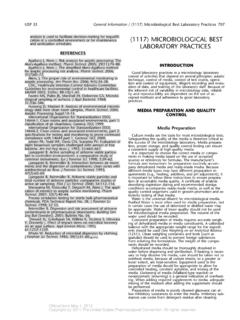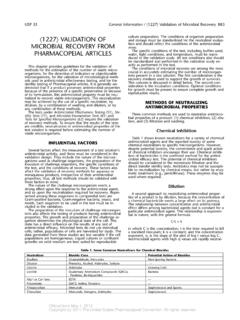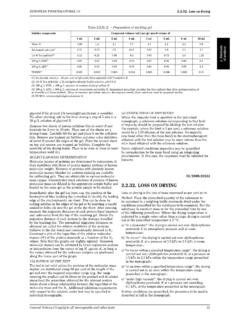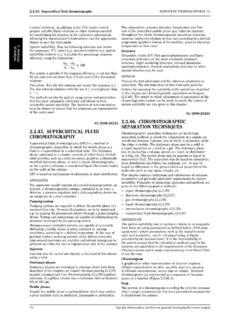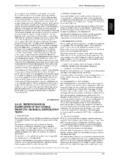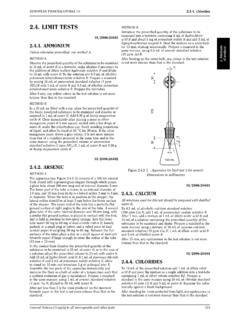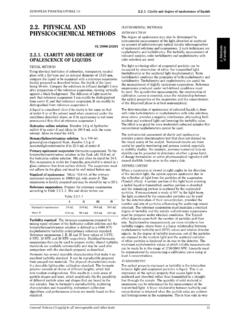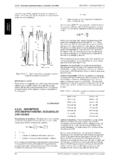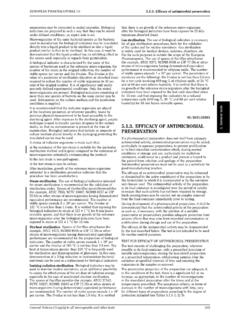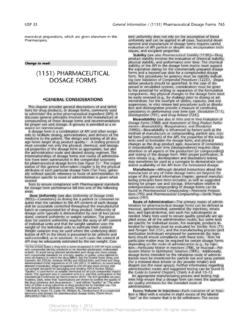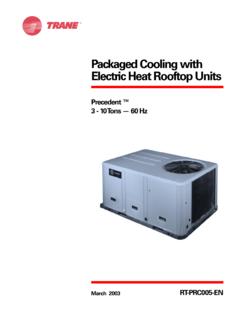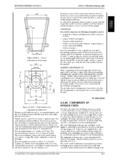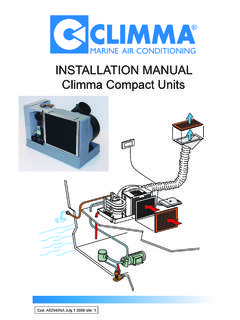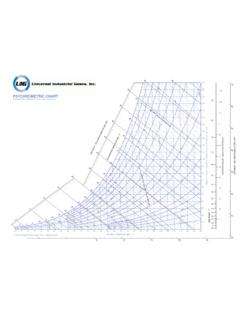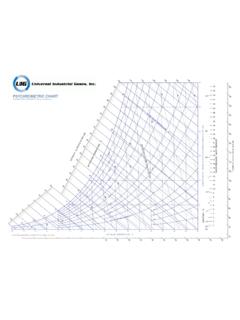Transcription of <905> UNIFORMITY OF DOSAGE UNITS - …
1 Accessed from by nEwp0rt1 on Fri Dec 02 22:02:37 EST 2011. 420 891 Thermal Analysis / Physical Tests USP 35. In addition, the method is reliable when the purity of the Solids (including sterile solids) that are packaged in sin- major component is greater than mol% and the mater- gle- unit containers, with or without active or inactive ials are not decomposed during the melting phase. (W3) added substances, that have been prepared from true Impurity levels calculated from thermograms are repro- solutions and freeze-dried in the final containers and are ducible and generally reliable within for ideal labeled to indicate this method of preparation; and compounds.
2 Hard capsules, uncoated tablets, or film-coated tablets, Compounds that exist in polymorphic form cannot be containing 25 mg or more of a drug substance compris- used in purity determination unless the compound is com- ing 25% or more, by weight, of the DOSAGE unit or, in pletely converted to one form. On the other hand, DSC and (W4) the case of hard capsules, the capsule contents, except DTA are inherently useful for detecting, and therefore moni- that UNIFORMITY of other drug substances present in toring, polymorphism. lesser proportions is demonstrated by meeting the re- Procedure The actual procedure and the calculations to quirements for Content UNIFORMITY .
3 Be employed for eutectic impurity analysis are dependent on the particular instrument used. Consult the manufactur- The test for Content UNIFORMITY is required for all DOSAGE er's literature and/or the thermal analysis literature for the forms not meeting the above conditions for the Weight . most appropriate technique for a given instrument. In any Variation event, it is imperative to keep in mind the limitations of solid solution formation, insolubility in the melt, polymor- Table 1. Application of Content UNIFORMITY (CU) and Weight phism, and decomposition during the analysis.
4 Variation (WV) Tests for DOSAGE Forms Dose & Ratio of Drug Substance 25 mg <25 mg and or DOSAGE Form Type Subtype 25% <25%. 905 UNIFORMITY OF DOSAGE Tablets Uncoated Film WV. WV. CU. CU. UNITS Coated Others CU CU. Hard WV CU. Suspension, This general chapter is harmonized with the correspond- Capsules emulsion, Soft ing texts of the European Pharmacopoeia and the Japanese or gel CU CU. Pharmacopoeia. Portions of the general chapter text that are Solutions WV WV. national USP text, and are not part of the harmonized text, Single are marked with symbols ( ) to specify this fact.
5 Compo- NOTE In this chapter, unit and DOSAGE unit are nent WV WV. synonymous. Solids in Solution To ensure the consistency of DOSAGE UNITS , each unit in a single- unit freeze- batch should have a drug substance content within a nar- containers Multiple dried in row range around the label claim. DOSAGE UNITS are defined compo- final con- as DOSAGE forms containing a single dose or a part of a dose nents tainer WV WV. of drug substance in each unit . The UNIFORMITY of DOSAGE UNITS specification is not intended to apply to suspensions, Others CU CU. emulsions, or gels in unit -dose containers intended for ex- Solutions in ternal, cutaneous administration.
6 unit -dose The term UNIFORMITY of DOSAGE unit is defined as the containers and into degree of UNIFORMITY in the amount of the drug substance among DOSAGE UNITS . Therefore, the requirements of this soft cap- chapter apply to each drug substance being comprised in sules WV WV. DOSAGE UNITS containing one or more drug substances, un- Others CU CU. less otherwise specified elsewhere in this Pharmacopeia. The UNIFORMITY of DOSAGE UNITS can be demonstrated by either of two methods, Content UNIFORMITY or Weight Varia- tion (see Table 1). The test for Content UNIFORMITY of prepara- CONTENT UNIFORMITY .
7 Tions presented in DOSAGE UNITS is based on the assay of the individual content of drug substance(s) in a number of Select not fewer than 30 UNITS , and proceed as follows for DOSAGE UNITS to determine whether the individual content is the DOSAGE form designated. within the limits set. The Content UNIFORMITY method may be Where different procedures are used for assay of the prep- applied in all cases. aration and for the Content UNIFORMITY test, it may be neces- The test for Weight Variation is applicable for the follow- sary to establish a correction factor to be applied to the ing DOSAGE forms: results of the latter.
8 1 European Pharmacopoeia and Japanese Pharmacopoeia text not accepted by the United States Pharmacopeia: Alternatively, products listed in item (4). Solutions enclosed in unit -dose containers and into soft above that do not meet the 25 mg/25% threshold limit may be tested for (W1) UNIFORMITY of DOSAGE UNITS by Mass Variation instead of the Content Uniform- capsules;. ity test if the concentration relative standard deviation (RSD) of the drug Solids (including powders, granules, and sterile solids) substance in the final DOSAGE UNITS is not more than 2%, based on process (W2) that are packaged in single- unit containers and contain validation data and development data, and if there has been regulatory ap- no active or inactive added substances; proval of such a change.
9 The concentration RSD is the RSD of the concentra- tion per DOSAGE unit (w/w or w/v), where concentration per DOSAGE unit equals the assay result per DOSAGE unit divided by the individual DOSAGE unit weight. See the RSD formula in Table 2.. Official from May 1, 2012. Copyright (c) 2011 The United States Pharmacopeial Convention. All rights reserved. Accessed from by nEwp0rt1 on Fri Dec 02 22:02:37 EST 2011. USP 35 Physical Tests / 905 uniformity of dosage units 421. Solid DOSAGE Forms Calculation of Acceptance Value Assay 10 UNITS individually using an appropriate analytical Calculate the acceptance value by the formula: method.
10 Calculate the acceptance value (see Table 2). Liquid or Semi-Solid DOSAGE Forms in which the terms are as defined in Table 2. Assay 10 UNITS individually using an appropriate analytical method. Carry out the assay on the amount of well-mixed material that is removed from an individual container in conditions of normal use, and express the results as deliv- ered dose. Calculate the acceptance value (see Table 2). Table 2. Variable Definition Conditions Value Mean of individual contents ( 1, 2, , n), expressed as a per- X centage of the label claim 1, 2, , n Individual contents of the UNITS tested, expressed as a percentage of the label claim n Sample size (number of UNITS in a sample).
